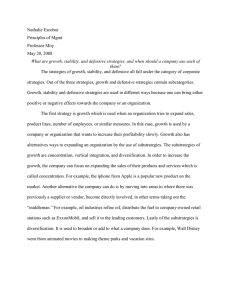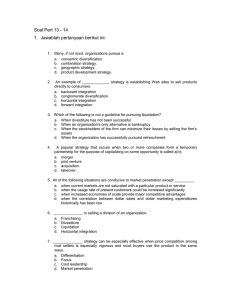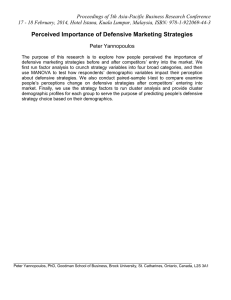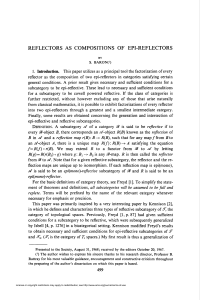Nathalie Escobar Principles of Mgmt Professor Moy May 20, 2008
advertisement
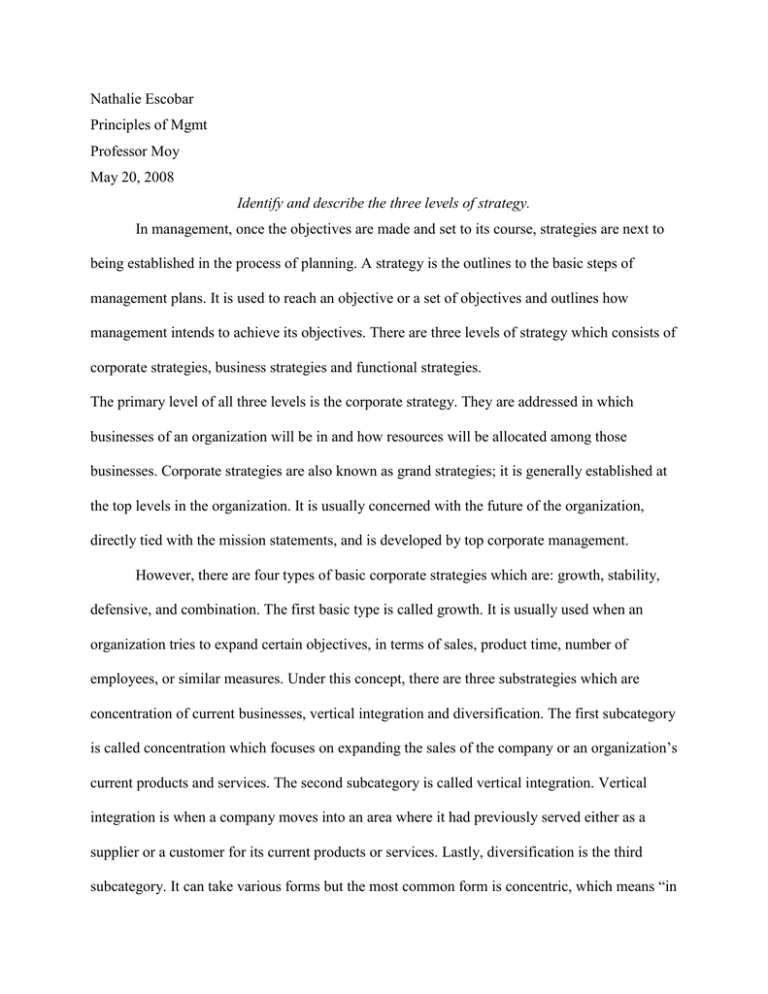
Nathalie Escobar Principles of Mgmt Professor Moy May 20, 2008 Identify and describe the three levels of strategy. In management, once the objectives are made and set to its course, strategies are next to being established in the process of planning. A strategy is the outlines to the basic steps of management plans. It is used to reach an objective or a set of objectives and outlines how management intends to achieve its objectives. There are three levels of strategy which consists of corporate strategies, business strategies and functional strategies. The primary level of all three levels is the corporate strategy. They are addressed in which businesses of an organization will be in and how resources will be allocated among those businesses. Corporate strategies are also known as grand strategies; it is generally established at the top levels in the organization. It is usually concerned with the future of the organization, directly tied with the mission statements, and is developed by top corporate management. However, there are four types of basic corporate strategies which are: growth, stability, defensive, and combination. The first basic type is called growth. It is usually used when an organization tries to expand certain objectives, in terms of sales, product time, number of employees, or similar measures. Under this concept, there are three substrategies which are concentration of current businesses, vertical integration and diversification. The first subcategory is called concentration which focuses on expanding the sales of the company or an organization’s current products and services. The second subcategory is called vertical integration. Vertical integration is when a company moves into an area where it had previously served either as a supplier or a customer for its current products or services. Lastly, diversification is the third subcategory. It can take various forms but the most common form is concentric, which means “in related fields.” Stability is the second type of basic corporate strategy. It is used when an organization is satisfied with its present course. The third kind of basic corporate strategy is called defensive. It used when a company wants or needs to reduce its operations. Defensive also has substrategies which are turnaround, divestiture, and liquidation. The first subcategory of defensive is called turnaround. It is designed to reverse the negative trend and get the organization back to profitability. Divestiture is the second subcategory. It is where the company sells or divests itself of a business or part of a business. The last subcategory is called liquidation. It is more as a last resort where the entire company is sold or dissolved. Last of all, the fourth type of corporate strategy is the combination. It is used when an organization simultaneously employs various strategies for different parts of the company. Business strategies are the next level from the three levels of corporate strategy. It is the secondary level of the three strategies and also known as the competitive strategy. Business strategies generally apply towards a single business unit and are usually classified as overall cost leadership, differentiation and focus. An overall cost leadership is a strategy that is designed to produce and deliver the product or service for a lower cost than then competition. It is usually attained through a combination that consists of both experience and efficiency. However, it requires the close attention of production methods, overhead, marginal customers, and overall cost minimization such as research, sales, and development. Another classification is called differentiation. It usually aims for the making of products or services in such a unique way that it results the organization to charge “higher-than-average” prices. Also, differentiation can acquire the use of many forms, such as design or brand image, quality, technology, customer service, or dealer network. The whole purpose of the differentiation strategy is to generally gain the brand loyalty of customers and an end result of lower prices. The last type of business strategy is called focus. This method of focus is used by companies as a way to direct their attention to develop a narrow market segment. The segment can consist of a special buyer group, a geographical market, or part of a product line. If a focus strategy is used, the firm can serve a well-developed but narrow market which can be better than competitors that may server as a broader or less defined market. The final level of all three levels of corporate strategy is called functional strategies. It is usually concerned with the activities of the different functional areas of the business. Some examples of the areas of business are production, finance, marketing, human resources, etc. Functional strategies generally support the business strategies and are highly concerned with the “how-to” issues. However, out of all the three strategies, functional strategy only takes in effect for a short period of time within one year or less. Strategies can increase an organization’s direction for the future and highly improve the planning process. With the use of these three corporate strategy levels, it can be very useful way to achieve management objectives. It can also benefit the development of an organization and find ways to expanding its goals and objectives. In addition, if the three primary three levels of corporate strategy don’t improve an organization, they can use the substrategies of either growth or defensive as another alternative.
